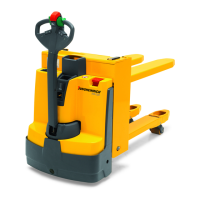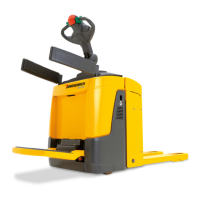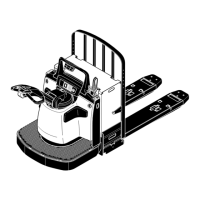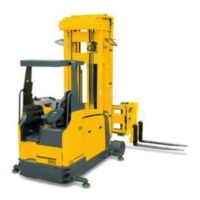E 5
0999.GB
4 Working with the truck
4.1 Safety regulations for operating mode Drive
Routes and working areas: Only such lanes and routes that are specially allocated
for truck traffic may be used. Unauthorised third parties must stay away from the wor-
king area. Loads may only be stored at places specially provided for this purpose.
Driving the vehicle: The driver must choose a driving speed suitable for the local
conditions. The truck must be driven at slow speed when negotiating bends or narrow
passages, when passing through swing doors and at blind spots. The driver must al-
ways keep an adequate braking distance between his truck and the vehicle in front
and he must be in control of the floor conveyor at all times. Sudden stopping (except
in emergencies), rapid U-turns and overtaking at dangerous or blind spots is not per-
mitted. Leaning or gripping out of the working and operating range is prohibited.
Visibility during driving: The driver must look into the driving direction and have a
sufficient overview of the driving route. If load units are transported which are obstruc-
ting the driver's view, the floor conveyor is to be driven with the load pointing to the
back. If this is not possible, a second person must give suitable warnings.
Driving on slopes: Driving on slopes or descents is only permitted, if they are defi-
ned as traffic routes and if the surface is clean and suitable for driving. In addition,
these routes must conform to the regulations for safe driving as defined in the tech-
nical truck specifications. Loads must always be carried at that end of the truck facing
uphill. U-turns, cutting obliquely over slopes or inclines and parking of the truck on slo-
pes or inclines is not permitted. Inclines must only be negotiated at slow speed with
the driver ready to brake at any moment.
Driving in lifts or on loading platforms: Lifts and loading platforms must only be
used, if they are of adequate load bearing capacity, if suitable for driving on, and if
authorised by the user of the truck for truck traffic. The truck must enter lifts with the
load in front and must take up a position which does not allow it to come into contact
with the walls of the lift shaft.
Persons riding in the lift together with the truck must only enter the lift after the truck
has come safely to a standstill, and must leave the lift before the truck.
Requirements for the load to be transported: Only loads that have been securely
fastened according to the regulations may be transported. Never transport loads that
have been stacked higher than the top of the fork carrier or the load backrest.
E 5
0999.GB
4 Working with the truck
4.1 Safety regulations for operating mode Drive
Routes and working areas: Only such lanes and routes that are specially allocated
for truck traffic may be used. Unauthorised third parties must stay away from the wor-
king area. Loads may only be stored at places specially provided for this purpose.
Driving the vehicle: The driver must choose a driving speed suitable for the local
conditions. The truck must be driven at slow speed when negotiating bends or narrow
passages, when passing through swing doors and at blind spots. The driver must al-
ways keep an adequate braking distance between his truck and the vehicle in front
and he must be in control of the floor conveyor at all times. Sudden stopping (except
in emergencies), rapid U-turns and overtaking at dangerous or blind spots is not per-
mitted. Leaning or gripping out of the working and operating range is prohibited.
Visibility during driving: The driver must look into the driving direction and have a
sufficient overview of the driving route. If load units are transported which are obstruc-
ting the driver's view, the floor conveyor is to be driven with the load pointing to the
back. If this is not possible, a second person must give suitable warnings.
Driving on slopes: Driving on slopes or descents is only permitted, if they are defi-
ned as traffic routes and if the surface is clean and suitable for driving. In addition,
these routes must conform to the regulations for safe driving as defined in the tech-
nical truck specifications. Loads must always be carried at that end of the truck facing
uphill. U-turns, cutting obliquely over slopes or inclines and parking of the truck on slo-
pes or inclines is not permitted. Inclines must only be negotiated at slow speed with
the driver ready to brake at any moment.
Driving in lifts or on loading platforms: Lifts and loading platforms must only be
used, if they are of adequate load bearing capacity, if suitable for driving on, and if
authorised by the user of the truck for truck traffic. The truck must enter lifts with the
load in front and must take up a position which does not allow it to come into contact
with the walls of the lift shaft.
Persons riding in the lift together with the truck must only enter the lift after the truck
has come safely to a standstill, and must leave the lift before the truck.
Requirements for the load to be transported: Only loads that have been securely
fastened according to the regulations may be transported. Never transport loads that
have been stacked higher than the top of the fork carrier or the load backrest.

